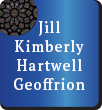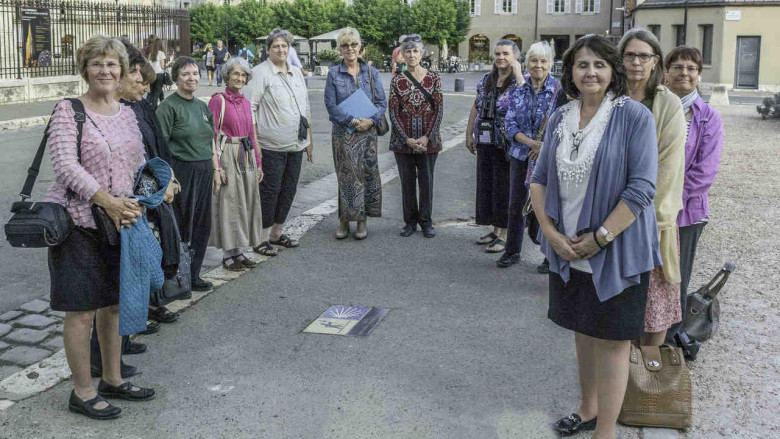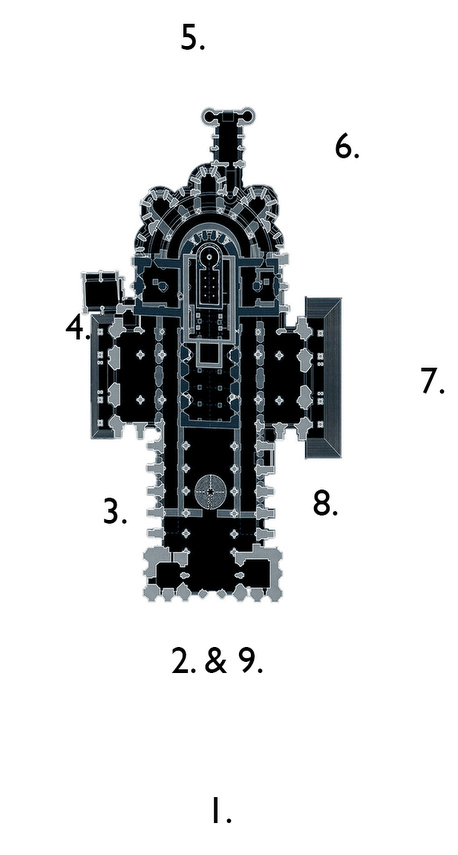A Prayer Walk To Help Pilgrims Ground Themselves at Chartres (pdf)
Circumambulation de la cathédrale de Chartres (pdf version française)
Station 1: Le Parvis
Begin on the far side of the garden area in the west of the cathedral
Wonder at the Chartres Cathedral in front of you. Perhaps you feel like the Jewish psalmist who wrote:
“I was glad when they said to me, ‘Let us go to the house of the LORD!’” Psalm 122:1
Gaze softly in silence for 2-3 minutes, while you let yourself become aware of where you are—and what you are sensing internally and externally as you “arrive” here.
Look up and find the highest statue in the central area of the west wall before you.
It is Jesus- holding out his right hand and welcoming you and all who come.
Make the same gesture he is demonstrating with his right hand and hold it. Sense this gesture from the inside out.
Next, make the same blessing gesture with your right hand that Jesus is making (thumb and fingers extended).
Hold it, feeling the messages your body is communicating.
In silence move slowly toward the cathedral.
Station 2: On the far side of the street from the West Facade
Shell of Pilgrimage to Compostela, Spain (Camino/Chemin St. Jacques)
Create a circle with the shell in the middle and practice the pilgrim ritual.
Bow your head: Humility,
Extend your arms out with clenched fist and open them: Release,
Turn your palms upwards (bring to womb level): Receive.
Place your hands over heart: say together: May the path lead us Home.
So be it!
Afterwards enter into an ancient and universal form of prayer—the moving around a sacred site with the intention to prepare to enter it.
This preparation can open your heart and our mind to whatever grace awaits.
Begin your circumambulation, continuing in silence.
Station 3: North Side: Remembering the medieval hospital in the crypt
Let us take several minutes to quietly pray for every sick place we recognize in our bodies, spirits and minds, joining our prayers to those of pilgrims of every age, asking for the help we need.
Song: Wait for the Lord, whose day is near. Wait for the Lord, keep watch, take heart. (Taizé)
Station 4: Seeking inspiration from our sisters and brothers in the faith. Modeste and Potentien: “martyrs of Chartres.”
Standing near the north porch on the west side below the statues of Modest and Potentien who are traditionally thought of as the “first Christian martyrs of Chartres.” Modeste was a convert to the Christianity was martyred at the request of her Roman father who ruled the area. Her bones and the bones of other converts believed to be thrown into the well in the crypt. A representation of the well is underneath her sculpture on the pillar.
Wells are deep places. They connect the earth and the sky. In their darkness, there is potentiality and life. Imagine receiving water from the well of the martyrs in the crypt and placing it somewhere on your body. Mark yourself with this water.
Sing: Nada te turbe (Taizé ) Nothing can trouble, nothing can frighten. Those who seek God shall never go wanting. Nothing can trouble, nothing can frighten. God alone fills us.
Continue on your journey around the cathedral, entering the gate to the Bishop’s Garden and walking to the part of the cathedral that extends into it the most.
Station 5: Eastern most point of the cathedral
The East is the symbolic focus point of the cathedral. It is the place of the rising sun and the rising Son. Throughout the ages, pilgrims to Notre Dame de Chartres came to pray to Mary because they believed that it was just too out of their own reach to get to God. But they believed that the mother of Jesus could help them. At Chartres, there are well over 200 different images of Mary in stone and stained glass, and that doesn’t count the literally hundreds of symbols that point to her, and the many representations of her on the liturgical items that are used here.
On the other side of the cathedral wall are images of Mary. In the earlier church the Notre Dame de la Belle Verrière, the best known window of the cathedral (now in the south choir ambulatory) would have been in the East.
In this cathedral we find images of Mary as a throne for her son, Jesus, The annunciation of Jesus’ birth to Mary and the visitation of Mary to Elizabeth, mother of John the Baptizer. On the lower level we find the window of the Apostles that explains Jesus’ relationship to his disciples and the world.
As you stand here in the East—facing the west—you are holding together in your body the same universal stories that we are reminded of in these windows. In you also lives the possibility of the balance of life with both male and female energies, of the potential for deep spiritual friendship, and for serving the world.
Song: Sanctuary God, prepare me to be a sanctuary pure and holy, tried and true. With thanksgiving, I’ll be a living sanctuary for You.
Station 6: Just beyond the gateway from the Bishop’s Garden on the South side facing the Cathedral
This is a place that reminds us of all the kinds and levels of support that the cathedral and the churches that existed in this spot since the fourth century have offered.
While considering the windows from the Crypt: We are reminded of all who have sought God’s help here. We re joining an immense “cloud of witnesses who have come before us.
While considering the Caveau des Éveques on the ground level, this burial place of those who have sought to lead God’s people through the ministries of the is church, and the chapel where the clergy have met to discern how to best lead, we are reminded of the institutional support that we can experience.
While considering the flying buttresses we can call to mind the support of all those who contributed to this constructing this building, to maintaining it, and to welcoming all those who have come throughout the centuries.
While considering the weathervane Archangel Michael on the top of the roof we are reminded of the unseen spiritual forces that offer help and guidance. On our pilgrim journey we are never alone, although we often forget this.
Stand looking at these symbols of support, allowing them to show themselves more clearly.
Sing (From a Navaho prayer-poem): Now I walk in beauty. Beauty is before me. Beauty is behind me. Above and below me.
Station 7: Below the South Porch looking at the sculpture of Jesus on the central portal trumeau (Le Beau Dieu)
Here at the South Porch, we have come to a place bathed in sunshine and hope. Here in the middle of the porch we find a sculpture that sums up well the spirit of time during which the cathedral was born and built. While in the past God had been distant, during the 12th and 13th centuries, God’s humanity was emphasized and we find sculptures like this one, of Jesus, the teacher, who is close to us, available to us, ready to show us the way (as represented by his big book).
Above him is one of the common depictions of the risen Christ here at Chartres, Can you tell what he is doing? He is holding his hands up to show us his wounds. Christ at Chartres is one who understands suffering and who even in his risen state retains the marks of it as if to remind pilgrims who come, “I understand, I understand…”
Contemplate one or both of these sculptures and what they are communicating to you as a pilgrim who has come to this place.
Pray the Lord’s Prayer using the words that are most familiar to you. Our Father, who art in heaven, hallowed be Thy name. Thy kingdom come, Thy will be done, on earth as it is in heaven. Give us this day our daily bread. And forgive us our sins, as we forgive those who sin against us. Lead us not into temptation, but deliver us from evil. For Thine is the kingdom, the power and the glory forever. Amen.
Station 8: Between the third and fourth stained glass windows (bays of the church): placing the labyrinth
We are directly in line with a large symbol of pilgrimage on the inside of the cathedral, the labyrinth. Notice what you can about the placement.
Count the flying buttresses on the side of the church. How many bays are there in between them? Seven. One way to understand the number seven is that is the joining of three and four. In medieval number symbolism 3 represented God, the Trinity and 4 the earth. So if we count down to the third and fourth bays (right in front of us) we will discover the symbolic meeting place of heaven and earth. And of course, this is where the builders placed the labyrinth.
As you stand on the entrance stone to the labyrinth, you can see the third window from the west. It tells the story of the Good Samaritan and depicts the man who was attacked as a pilgrim, who was rescued by the least likely person, a Samaritan, who is represented as Jesus himself. Be sure to notice the window when you are inside the church.
For now, take a moment to once again ground yourself, feeling the Chartrain soil beneath you, and noticing the beautiful Chartrain sky above.. Pilgrims who have come to this sacred site are being reminded that we hold together all things in our own bodies and that we are walking a pathway that is leading us deeper and deeper into God’s love.
Body Percussion: Using your hands on your thighs to keep the beat, say out loud, “Pilgrim, pilgrim, pilgrim. There is no way. There is no way. There is no way. You find your way, walking, walking, walking, walking.
Continuing on silence, make your way back to the pilgrim shel in the westl.
Station 9: On the far side of the street from the West Facade
Shell of Pilgrimage to Compostela, Spain (Camino/Chemin St. Jacques)
Reflect on how God has communicated with you during your walk around the outside of the cathedral. What word or image do you want to guard as especially meaningful?
Once again, use the pilgrim ritual to express your deep desire.
With your head bowed, feel that the first step on the path is humbleness.
By holding two fists out in front and opening them down, embody letting go.
Turning your palms up in a gesture of openness, signal your readiness to receive whatever is given.
Now, as both hands rest over your heart, pray out loud, “May the path lead me home.”
Cielle Tewksbury (1938-2004) created this ritual. The wording has been slightly altered by Jill K H Geoffrion.
Receive an Egyptian benediction for pilgrims which shared by Phil Cousineau in his book The Art of Pilgrimage: “Be safe and well. Peace, love, and courage!”


